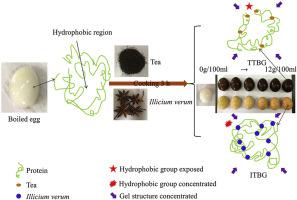当前位置:
X-MOL 学术
›
Food Hydrocoll.
›
论文详情
Our official English website, www.x-mol.net, welcomes your
feedback! (Note: you will need to create a separate account there.)
Effects of tea and illicium verum braise on physicochemical characteristics, microstructure, and molecular structure of heat-induced egg white protein gel
Food Hydrocolloids ( IF 11.0 ) Pub Date : 2021-01-01 , DOI: 10.1016/j.foodhyd.2020.106181 Hui Xue , Meng Xu , Mingfu Liao , Wenxiang Luo , Guowen Zhang , Yonggang Tu , Yan Zhao
Food Hydrocolloids ( IF 11.0 ) Pub Date : 2021-01-01 , DOI: 10.1016/j.foodhyd.2020.106181 Hui Xue , Meng Xu , Mingfu Liao , Wenxiang Luo , Guowen Zhang , Yonggang Tu , Yan Zhao

|
Abstract Tea and illicium verum are the main raw materials of marinated egg, and play an important role in the braising process. In this study, effects of tea and illicium verum braise on the physicochemical characteristics, microstructure, and molecular structure of the heat-induced egg white protein gel were investigated. Results indicated that, with an increased in tea and illicium verum concentration, all of the moisture content, T2 and pH of tea treated boiled egg (TTBG) and illicium verum treated boiled egg (ITBG) showed a decreased trend. The water holding capacity of TTBG showed an increased first and then remained unchanged, while that of ITBG showed a rapid increased first and then decreased continually. The free sulfhydryl group and the hardness of both TTBG and ITBG showed an increased rapidly, and especially, the hardness of ITBG reached 2161.83 g at last. The surface hydrophobicity of TTBG showed an overall increased trend, while that of ITBG showed a decreased trend with a slight red-shift. Environmental scanning electron microscopy showed that TTBG gradually formed small compact aggregates, while ITBG gradually formed hypertrophy porous aggregates. Fourier transform infrared spectrometry displayed that the intramolecular β-sheets of both TTBG and ITBG showed a decreased trend, while the intermolecular β-sheets, α-helices, β-turn and intermolecular antiparallel β-sheets showed an increased trend. In general, both tea and illicium verum could improve the gel strength of boiled egg, but in a different way, and the effect of illicium verum braise on the strength of enhancing gel was better than that of tea.
中文翻译:

茶叶和八角红烧对热诱导蛋清蛋白凝胶理化特性、微观结构和分子结构的影响
摘要 茶叶和八角是卤蛋的主要原料,在卤制过程中发挥着重要作用。在本研究中,研究了茶和八角红烧对热诱导蛋清蛋白凝胶的理化特性、微观结构和分子结构的影响。结果表明,随着茶叶和八角浓度的增加,茶叶处理的煮鸡蛋(TTBG)和八角处理的煮鸡蛋(ITBG)的水分含量、T2和pH值均呈下降趋势。TTBG的持水量呈先增加后保持不变的趋势,而ITBG的持水量呈先快速增加后持续下降的趋势。TTBG 和 ITBG 的游离巯基和硬度均迅速增加,尤其是,ITBG的硬度最终达到2161.83g。TTBG的表面疏水性总体呈增加趋势,而ITBG的表面疏水性呈下降趋势,略有红移。环境扫描电镜显示TTBG逐渐形成小的致密聚集体,而ITBG逐渐形成肥大的多孔聚集体。傅里叶变换红外光谱显示,TTBG和ITBG的分子内β-折叠均呈减少趋势,而分子间β-折叠、α-螺旋、β-转角和分子间反平行β-折叠呈增加趋势。总的来说,茶和八角都可以提高煮鸡蛋的凝胶强度,但方式不同,八角红烧对增强凝胶强度的作用优于茶。TTBG的表面疏水性总体呈增加趋势,而ITBG的表面疏水性呈下降趋势,略有红移。环境扫描电镜显示TTBG逐渐形成小的致密聚集体,而ITBG逐渐形成肥大的多孔聚集体。傅里叶变换红外光谱显示,TTBG和ITBG的分子内β-折叠均呈减少趋势,而分子间β-折叠、α-螺旋、β-转角和分子间反平行β-折叠呈增加趋势。总的来说,茶和八角都可以提高煮鸡蛋的凝胶强度,但方式不同,八角红烧对增强凝胶强度的作用优于茶。TTBG的表面疏水性总体呈增加趋势,而ITBG的表面疏水性呈下降趋势,略有红移。环境扫描电镜显示TTBG逐渐形成小的致密聚集体,而ITBG逐渐形成肥大的多孔聚集体。傅里叶变换红外光谱显示TTBG和ITBG的分子内β-折叠呈减少趋势,而分子间β-折叠、α-螺旋、β-转角和分子间反平行β-折叠呈增加趋势。总的来说,茶和八角都可以提高煮鸡蛋的凝胶强度,但方式不同,八角红烧对增强凝胶强度的作用优于茶。而ITBG则呈下降趋势,略有红移。环境扫描电镜显示TTBG逐渐形成小的致密聚集体,而ITBG逐渐形成肥大的多孔聚集体。傅里叶变换红外光谱显示,TTBG和ITBG的分子内β-折叠均呈减少趋势,而分子间β-折叠、α-螺旋、β-转角和分子间反平行β-折叠呈增加趋势。总的来说,茶和八角都可以提高煮鸡蛋的凝胶强度,但方式不同,八角红烧对增强凝胶强度的作用优于茶。而ITBG则呈下降趋势,略有红移。环境扫描电镜显示TTBG逐渐形成小的致密聚集体,而ITBG逐渐形成肥大的多孔聚集体。傅里叶变换红外光谱显示,TTBG和ITBG的分子内β-折叠均呈减少趋势,而分子间β-折叠、α-螺旋、β-转角和分子间反平行β-折叠呈增加趋势。总的来说,茶和八角都可以提高煮鸡蛋的凝胶强度,但方式不同,八角红烧对增强凝胶强度的作用优于茶。而ITBG逐渐形成肥大的多孔聚集体。傅里叶变换红外光谱显示TTBG和ITBG的分子内β-折叠呈减少趋势,而分子间β-折叠、α-螺旋、β-转角和分子间反平行β-折叠呈增加趋势。总的来说,茶和八角都可以提高煮鸡蛋的凝胶强度,但方式不同,八角红烧对增强凝胶强度的作用优于茶。而ITBG逐渐形成肥大的多孔聚集体。傅里叶变换红外光谱显示,TTBG和ITBG的分子内β-折叠均呈减少趋势,而分子间β-折叠、α-螺旋、β-转角和分子间反平行β-折叠呈增加趋势。总的来说,茶和八角都可以提高煮鸡蛋的凝胶强度,但方式不同,八角红烧对增强凝胶强度的作用优于茶。
更新日期:2021-01-01
中文翻译:

茶叶和八角红烧对热诱导蛋清蛋白凝胶理化特性、微观结构和分子结构的影响
摘要 茶叶和八角是卤蛋的主要原料,在卤制过程中发挥着重要作用。在本研究中,研究了茶和八角红烧对热诱导蛋清蛋白凝胶的理化特性、微观结构和分子结构的影响。结果表明,随着茶叶和八角浓度的增加,茶叶处理的煮鸡蛋(TTBG)和八角处理的煮鸡蛋(ITBG)的水分含量、T2和pH值均呈下降趋势。TTBG的持水量呈先增加后保持不变的趋势,而ITBG的持水量呈先快速增加后持续下降的趋势。TTBG 和 ITBG 的游离巯基和硬度均迅速增加,尤其是,ITBG的硬度最终达到2161.83g。TTBG的表面疏水性总体呈增加趋势,而ITBG的表面疏水性呈下降趋势,略有红移。环境扫描电镜显示TTBG逐渐形成小的致密聚集体,而ITBG逐渐形成肥大的多孔聚集体。傅里叶变换红外光谱显示,TTBG和ITBG的分子内β-折叠均呈减少趋势,而分子间β-折叠、α-螺旋、β-转角和分子间反平行β-折叠呈增加趋势。总的来说,茶和八角都可以提高煮鸡蛋的凝胶强度,但方式不同,八角红烧对增强凝胶强度的作用优于茶。TTBG的表面疏水性总体呈增加趋势,而ITBG的表面疏水性呈下降趋势,略有红移。环境扫描电镜显示TTBG逐渐形成小的致密聚集体,而ITBG逐渐形成肥大的多孔聚集体。傅里叶变换红外光谱显示,TTBG和ITBG的分子内β-折叠均呈减少趋势,而分子间β-折叠、α-螺旋、β-转角和分子间反平行β-折叠呈增加趋势。总的来说,茶和八角都可以提高煮鸡蛋的凝胶强度,但方式不同,八角红烧对增强凝胶强度的作用优于茶。TTBG的表面疏水性总体呈增加趋势,而ITBG的表面疏水性呈下降趋势,略有红移。环境扫描电镜显示TTBG逐渐形成小的致密聚集体,而ITBG逐渐形成肥大的多孔聚集体。傅里叶变换红外光谱显示TTBG和ITBG的分子内β-折叠呈减少趋势,而分子间β-折叠、α-螺旋、β-转角和分子间反平行β-折叠呈增加趋势。总的来说,茶和八角都可以提高煮鸡蛋的凝胶强度,但方式不同,八角红烧对增强凝胶强度的作用优于茶。而ITBG则呈下降趋势,略有红移。环境扫描电镜显示TTBG逐渐形成小的致密聚集体,而ITBG逐渐形成肥大的多孔聚集体。傅里叶变换红外光谱显示,TTBG和ITBG的分子内β-折叠均呈减少趋势,而分子间β-折叠、α-螺旋、β-转角和分子间反平行β-折叠呈增加趋势。总的来说,茶和八角都可以提高煮鸡蛋的凝胶强度,但方式不同,八角红烧对增强凝胶强度的作用优于茶。而ITBG则呈下降趋势,略有红移。环境扫描电镜显示TTBG逐渐形成小的致密聚集体,而ITBG逐渐形成肥大的多孔聚集体。傅里叶变换红外光谱显示,TTBG和ITBG的分子内β-折叠均呈减少趋势,而分子间β-折叠、α-螺旋、β-转角和分子间反平行β-折叠呈增加趋势。总的来说,茶和八角都可以提高煮鸡蛋的凝胶强度,但方式不同,八角红烧对增强凝胶强度的作用优于茶。而ITBG逐渐形成肥大的多孔聚集体。傅里叶变换红外光谱显示TTBG和ITBG的分子内β-折叠呈减少趋势,而分子间β-折叠、α-螺旋、β-转角和分子间反平行β-折叠呈增加趋势。总的来说,茶和八角都可以提高煮鸡蛋的凝胶强度,但方式不同,八角红烧对增强凝胶强度的作用优于茶。而ITBG逐渐形成肥大的多孔聚集体。傅里叶变换红外光谱显示,TTBG和ITBG的分子内β-折叠均呈减少趋势,而分子间β-折叠、α-螺旋、β-转角和分子间反平行β-折叠呈增加趋势。总的来说,茶和八角都可以提高煮鸡蛋的凝胶强度,但方式不同,八角红烧对增强凝胶强度的作用优于茶。











































 京公网安备 11010802027423号
京公网安备 11010802027423号